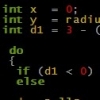This is basically the discussion that led me to post here - two sides both basically saying "I've done it successfully, and you can't really do it the way that the other people do it". Obviously this can't be entirely true.  I suspect there is more to it.
I suspect there is more to it.
Let me ask some more concrete questions.
No shared state, messages are immutable, and there is no reliability at the message or networking level.
Ok - but there is so much in game development that I can't imagine trying to code in this way. Say a player wants to buy an item from a store. The shared state model works like this:
BuyItem(player, store, itemID):
Check player has enough funds, abort if not
Check itemID exists in store inventory, abort if not
Deduct funds from player
Add funds to store
Add instance of itemID to player inventory
Commit player funds and inventory to DB
Notify player client and any observing clients of purchase
This is literally a 7-line function if you have decent routines already set up. Let's say you have to do it in a message-passing way, where the store and player are potentially in different processes. What I see - assuming you have coroutines or some other syntactic sugar to make this look reasonably sequential rather than callback hell - is something like this:
BuyItem(player, store, itemID):
Check player has enough funds, abort if not
Ask store if it has itemID in store inventory. Wait for response.
If store replied that it did not have the item in inventory:
abort.
Check player STILL has enough funds, abort if not
Deduct funds from player
Tell store to add funds. Wait for response.
If store replied that it did not have the item in inventory:
add funds to player
abort
Add instance of itemID to player inventory
Commit player funds to DB
Notify player client and any observing clients of purchase
This is at least 30% longer (not counting any extra code for the store) and has to include various extra error-checks, which are going to make things error-prone. I suspect it gets even more complex when you try and trade items in both directions because you need both sides to be able to place items in escrow before the exchange (whereas here, it was just the money).
So... is there an easier or safer way I could have written this? I wouldn't even attempt this in C++ - without coroutines it would be hard to maintain the state through the routine. I suppose some system that allows me to perform a rollback of an actor would simplify the error-handling but there are still more potential error cases than if you had access to both sides of the trade and could perform it atomically.
You talk about "using an actor with a FSM", but I can't imagine having to write an FSM for each of the states in the above interaction. Again, comparing that to a 7-line function, it's hard to justify in programmer time, even if it undoubtedly scales further. I appreciate something like Akka simplifies both the message-passing and the state machine aspects, so there is that - but it's still a fair bit of extra complexity, right? (Writing a message handler for each state, swapping the message handler each time, stashing messages for other states while you do so, etc.)
Maybe you can generalise a bit - eg. make all your buying/selling/giving/stealing into one single 'trade' operation? Then at least you're not writing unique code in each case.
As for "writing the code so all messages are idempotent" - is that truly practical? I mean, beyond the trivial but worthless case of attaching a unique ID to every message and checking that the message hasn't been already executed, of course. For example, take the trading code above - if one actor wants to send 10 gold pieces to another, how do you handle that in an idempotent way? You can't send "add 10 gold" because that will give you 20 if the message arrives twice. You can't send "set gold to 50" because you didn't know the actor had 40 gold in the first place.
Perhaps that is not the sort of operation you want to make idempotent, and instead have the persistent store treat it as a transaction. Fair enough, and the latency wouldn't matter if you only do this for things that don't occur hundreds of times per second and if your language makes it practical. (But maybe there aren't all that many such routines? The most common one is movement, and that is easily handled in an idempotent way, certainly.)
Forgive my ignorance if there is a simple and well-known answer to this problem; it's been a while since I examined distributed systems on an academic level.










